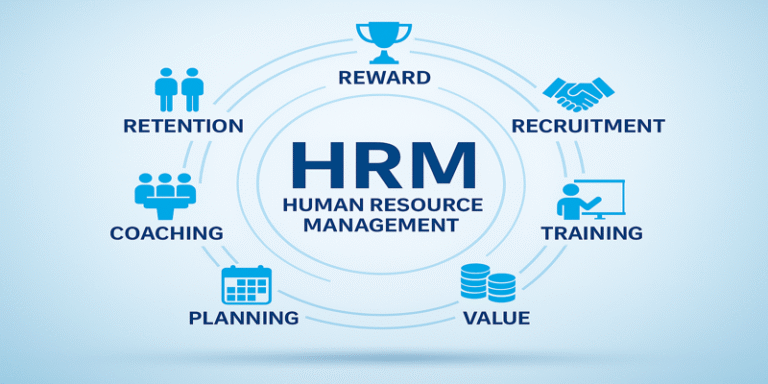Human Resource Management (HRM) is the strategic approach to managing an organisation’s most valuable asset—its people. HRM encompasses a wide range of activities aimed at maximising employee performance, satisfaction, and contribution to the organisation’s goals. As Torrington et al. (2017) emphasise, HRM goes beyond administrative personnel management, positioning itself as a driver of strategic alignment between workforce capabilities and organisational success.
This paper provides a detailed overview of key topics in HRM, drawing upon insights from academic textbooks, peer-reviewed journal articles, and reputable professional resources.
1.0 Recruitment and Selection
Recruitment and selection are among the most fundamental HRM functions. These processes involve attracting, shortlisting, interviewing, and hiring candidates to fill vacancies. According to Cascio and Aguinis (2011), the quality of recruitment and selection decisions significantly impacts long-term organisational performance, as hiring the right people ensures cultural fit and job success.
Further, Breaugh (2017) argues that effective recruitment requires a balance between employer branding, job analysis, and structured assessments to avoid biases and enhance fairness. The Chartered Institute of Personnel and Development (CIPD, 2022) also highlights the growing use of technology, such as artificial intelligence and online platforms, in recruitment to improve efficiency and candidate experience.
Thus, recruitment and selection not only meet immediate staffing needs but also serve as a foundation for building a sustainable talent pipeline.
2.0 Training and Development
Training and development (T&D) are central to improving employee skills, knowledge, and career growth. According to Noe et al. (2019), HR professionals are tasked with conducting training needs analysis, designing effective learning programmes, and evaluating outcomes to ensure employees acquire relevant competencies.
Kirkpatrick’s Four-Level Training Evaluation Model (Kirkpatrick & Kirkpatrick, 2006) underscores the importance of assessing training impact at multiple levels: reaction, learning, behaviour, and results. Furthermore, research by Salas et al. (2012) stresses that continuous training fosters employee engagement, innovation, and adaptability, especially in dynamic industries.
In the context of the digital era, organisations increasingly adopt e-learning platforms, virtual simulations, and micro-learning to enhance accessibility and flexibility (London, 2021). Ultimately, T&D plays a strategic role in sustaining organisational competitiveness.
3.0 Performance Management
Performance management (PM) refers to systematic processes for planning, monitoring, and reviewing employee performance. According to Armstrong and Baron (2017), performance management is not merely an appraisal tool but a continuous cycle of goal setting, feedback, and developmental support.
Recent research has shifted from annual performance appraisals to continuous performance management, supported by real-time data and feedback mechanisms (Pulakos et al., 2019). This evolution recognises the importance of agility, especially in organisations operating in volatile and competitive markets.
Furthermore, effective performance management ensures alignment between individual objectives and wider organisational strategy, thereby boosting motivation, productivity, and retention.
4.0 Compensation and Benefits
Compensation and benefits constitute a critical aspect of HRM. They include financial rewards (such as salary, bonuses, and incentives) and non-financial rewards (such as recognition, flexible working, and career development opportunities).
According to Milkovich and Newman (2016), compensation systems should be designed to ensure internal equity, external competitiveness, and individual performance recognition. Research by Gerhart and Fang (2015) also shows that well-structured rewards systems enhance employee engagement and reduce turnover.
The growing emphasis on total reward strategies reflects a shift from purely financial packages to holistic offerings that address employee well-being and work-life balance (CIPD, 2021). Consequently, compensation and benefits not only attract talent but also strengthen employee commitment and organisational performance.
5.0 Employee Relations
Employee relations (ER) concern the management of the employer–employee relationship and the resolution of workplace conflicts. Gomez-Mejia et al. (2016) note that positive employee relations foster trust, engagement, and loyalty.
Employee relations practices often involve collective bargaining, grievance handling, and promoting organisational culture. Guest (2017) argues that a partnership approach to ER, which values employee voice and participation, improves organisational outcomes.
Moreover, the modern ER landscape has expanded to address issues such as diversity and inclusion, employee well-being, and psychological safety. Such initiatives strengthen the psychological contract between employer and employee, ultimately enhancing morale and reducing disputes.
6.0 Workforce Planning
Workforce planning is the process of anticipating future staffing needs and developing strategies to meet them. According to Deloitte (2017), effective workforce planning ensures that organisations maintain the right people, with the right skills, in the right roles, at the right time.
This requires alignment between business objectives and talent strategies, alongside consideration of factors such as demographic shifts, technological advancements, and labour market trends. Collings et al. (2018) highlight that workforce planning is a core component of strategic HRM, enabling organisations to respond proactively to globalisation and digitalisation pressures.
As organisations face uncertainties such as automation and global talent shortages, workforce planning has become increasingly crucial in ensuring sustainability and resilience.
7.0 Legal Compliance
Legal compliance is a vital responsibility of HRM, covering adherence to employment law, health and safety regulations, and equality legislation. Mathis et al. (2017) stress that HR professionals must monitor evolving legal requirements to minimise legal risks and maintain fairness.
In the UK, key legislation includes the Equality Act 2010, the Employment Rights Act 1996, and the Health and Safety at Work Act 1974. Non-compliance may result in fines, reputational damage, or legal disputes.
Furthermore, legal compliance has expanded to include data protection under the General Data Protection Regulation (GDPR), reflecting the significance of safeguarding employee information (ICO, 2022). Thus, HRM ensures both ethical and legal governance in people management.
8.0 HR Metrics and Analytics
HR metrics and analytics are increasingly used to measure and improve HR effectiveness. According to Rasmussen et al. (2018), HR analytics enables organisations to demonstrate the value of HR practices by linking them to business outcomes such as productivity, profitability, and turnover.
Metrics may include employee turnover rates, cost-per-hire, and training ROI. Advances in big data and predictive analytics have empowered HR to move from descriptive to strategic analytics, enabling better decision-making (Minbaeva, 2018).
The CIPD (2020) notes that data-driven HRM not only enhances evidence-based decision-making but also strengthens HR’s role as a strategic business partner.
Human Resource Management encompasses a broad range of activities, from recruitment and training to performance management, employee relations, and HR analytics. Each element contributes to the creation of a workforce that is engaged, motivated, and strategically aligned with organisational objectives.
As the workplace evolves due to technological advances, globalisation, and changing employee expectations, HRM must adapt to remain relevant. By leveraging data, ensuring legal compliance, and prioritising employee well-being, HRM secures its role as a driver of sustainable organisational success.
References
Armstrong, M. and Baron, A. (2017) Performance Management: Key Strategies and Practical Guidelines. London: Kogan Page.
Breaugh, J. (2017) ‘The contribution of job analysis to recruitment’, Human Resource Management Review, 27(3), pp. 460–472.
Cascio, W.F. and Aguinis, H. (2011) Applied Psychology in Human Resource Management. 7th edn. London: Pearson.
Chartered Institute of Personnel and Development (CIPD) (2020) People analytics: driving business performance with people data. Available at: https://www.cipd.co.uk (Accessed: 16 August 2025).
Chartered Institute of Personnel and Development (CIPD) (2021) Reward management: factsheet. Available at: https://www.cipd.co.uk (Accessed: 16 August 2025).
Chartered Institute of Personnel and Development (CIPD) (2022) Recruitment: an overview. Available at: https://www.cipd.co.uk (Accessed: 16 August 2025).
Collings, D.G., Mellahi, K. and Cascio, W.F. (2018) The Oxford Handbook of Talent Management. Oxford: Oxford University Press.
Deloitte (2017) Global Human Capital Trends 2017: Rewriting the rules for the digital age. Available at: https://www2.deloitte.com/global/en/pages/human-capital/articles/introduction-human-capital-trends.html (Accessed: 16 August 2025).
Gerhart, B. and Fang, M. (2015) ‘Pay, intrinsic motivation, extrinsic motivation, performance, and creativity in the workplace’, Human Resource Management Review, 25(1), pp. 1–16.
Gomez-Mejia, L.R., Balkin, D.B. and Cardy, R.L. (2016) Managing Human Resources. 8th edn. London: Pearson.
Guest, D. (2017) ‘Human resource management and employee well-being: Towards a new analytic framework’, Human Resource Management Journal, 27(1), pp. 22–38.
ICO (2022) Guide to the General Data Protection Regulation (GDPR). Available at: https://ico.org.uk (Accessed: 16 August 2025).
Kirkpatrick, D.L. and Kirkpatrick, J.D. (2006) Evaluating Training Programs: The Four Levels. 3rd edn. San Francisco: Berrett-Koehler.
London, M. (2021) ‘Developing employees in the digital age’, Organisational Dynamics, 50(3), p. 100817.
Mathis, R.L., Jackson, J.H. and Valentine, S.R. (2017) Human Resource Management. 15th edn. Boston: Cengage Learning.
Milkovich, G.T. and Newman, J.M. (2016) Compensation. 12th edn. New York: McGraw-Hill Education.
Minbaeva, D. (2018) ‘Building credible human capital analytics for organisational competitive advantage’, Human Resource Management, 57(3), pp. 701–713.
Noe, R.A., Hollenbeck, J.R., Gerhart, B. and Wright, P.M. (2019) Human Resource Management: Gaining a Competitive Advantage. 11th edn. New York: McGraw-Hill.
Pulakos, E.D., Hanson, R.M., Arad, S. and Moye, N. (2019) ‘Performance management can be fixed: An evidence-based approach’, Industrial and Organisational Psychology, 12(1), pp. 51–76.
Rasmussen, T., Ulrich, D. and Barney, J.B. (2018) ‘Measuring and analysing human capital and human resource metrics’, Organisational Dynamics, 47(3), pp. 144–157.
Salas, E., Tannenbaum, S.I., Kraiger, K. and Smith-Jentsch, K.A. (2012) ‘The science of training and development in organisations: What matters in practice’, Psychological Science in the Public Interest, 13(2), pp. 74–101.
Torrington, D., Hall, L., Taylor, S. and Atkinson, C. (2017) Human Resource Management. 10th edn. Harlow: Pearson Education.









